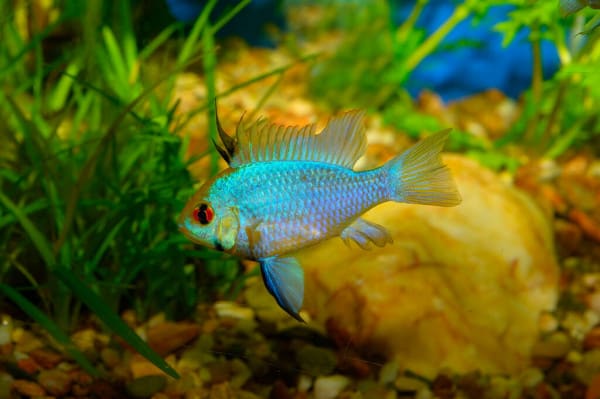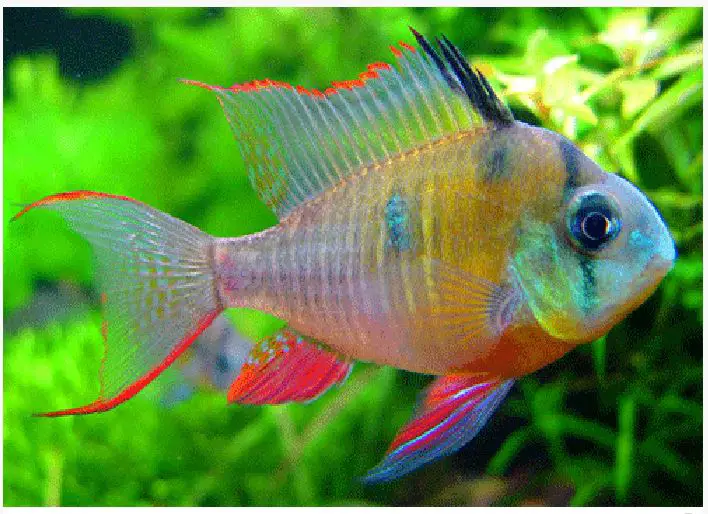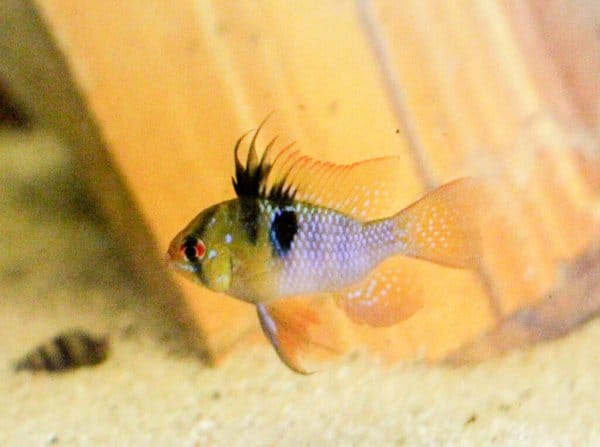Is It Easy to Breed Ram Fish?
We always find new arrivals in the aquarium trade. But sometimes, the classics are also worth rediscovering! And few dwarf cichlid types are as well known and loved as the Ram Cichlid! With all the Ram Cichlid types and colors they come in, it's worth getting to know what's available and how to breed them.
Table of Contents
- Getting to Know the Butterfly Cichlid
- Ram Cichlid Types
- Can You Mix Ram Cichlid Types?
- Aquarium Setup and Tank Mates for Ram Cichlids
- Water Parameters
- Feeding Ram Cichlids
- Tank Mates for Ram Cichlids
- Breeding Ram Cichlids
- Sexing Ram Cichlids
- Breeding Ram Cichlids and Raising the Fry
- Conclusion
Getting to Know the Butterfly Cichlid
Butterfly Cichlid. Ramirez's Dwarf Cichlid. Blue Ram. German Ram. Ram Cichlid. These are just a few of the many, many names that Mikrogeophagus ramirezi goes by! As one of the most popular South American dwarf cichlids, the Ram is a beautiful fish that's a favorite of aquarists of all skill varieties.
The wild type is found exclusively in the Orinoco River Basin, whose slow-moving waters seasonally flood the savannas of Colombia and Venezuela in South America. The mixture of floodwater and plant matter stains their home rivers a dark tea color that keeps the pH and water hardness low. But tank-raised varieties of the Ram Cichlid tend to be much less demanding.
Like most cichlids, they provide parental care for their eggs and fry during successful breeding. They also become much more aggressive during this stage, but with a bit of space, their tank mates should be fine!
Ram Cichlid Types
There are several Ram cichlid types, but they have similar to identical care requirements. All varieties of Mikrogeophagus ramirezi have a maximum length of 2.5 to 3 inches, regardless of appearance.
German Blue Rams

Of all the Ram cichlids out there, the German Blue Ram is by far the most popular. They closely resemble the wild variety Ram cichlid, except they have brighter, denser blue spangling along their flanks. And since they are all tank bred, they are much hardier than wild-caught Ram cichlids, which need excellent water quality to survive.
German Gold Ram

German Gold or Golden Rams are a distant second on the popularity scale. It's easy to see how they get their name: the yellow tones of Gold Rams outshine every other color and become even more intense when the little fish are breeding or fighting. The Golden Ram is just as easy to keep as the German Blue and also comes in long-finned and balloon varieties!
Electric Blue Rams

Out of all the varieties of Ram cichlid, the Electric Blue Ram is the most in-demand kind. The Electric Blue Ram is entirely covered in bright, iridescent scales that catch the light in a dramatic way. A bright red eye completes the picture – and both males and females are equally beautiful! One thing to consider is that the Electric Blue Ram Cichlid is a little more sensitive than the rest. They have been selectively bred to strengthen their blue colors and are less resistant to disease and poor water quality.
Black Rams
Black Rams are the newest variety to enter the aquarium market. These Ram cichlids have a smokey grey to jet black color, mixed with faint red, yellow, and blue scales. While they are pricey, Black Rams are just as hardy as the standard blue Ram!
Bolivian Ram

The Bolivian Ram is actually another species (Mikrogeophagus altispinosus) that's rarer than the "true" Ram Cichlid. Bolivian Rams are slightly larger, regularly reaching 3 to 3.5 inches, and are a little more subdued in coloration. But they are quite hardy and not as aggressive as the German Blue Ram. Just don't keep them alongside each other because there is a chance they may interbreed.
Can You Mix Ram Cichlid Types?
Absolutely! Ram cichlids of all types can live alongside one another with ease and will even interbreed if kept together. With so much potential variety, color-wise, a tank full of just Ram cichlids can be a beautiful sight! It's not a good idea to keep Bolivian Rams alongside standard Ram cichlids, though; should you give away the fry, their mixed parentage can lead to issues for future breeders.
Just keep in mind that, like all dwarf cichlids, Ram cichlids are quite territorial. You'll have to plan in order to ensure the males have space for territories and females don't get harassed constantly. You can also keep different Ram types together in regular community tanks alongside tetras, barbs, livebearers, and other tropical fish!
Aquarium Setup and Tank Mates for Ram Cichlids
Water Parameters
Providing proper water conditions is the most important part of caring for a healthy Ram. You should try to provide neutral to acidic water (pH 6.0-7.0) or even blackwater conditions (pH 4.5-6.0) if possible. Ram cichlids thrive in acidity. Tank-raised Rams will tolerate mild alkalinity (up to pH 7.5), but they do much better in acidic conditions and still require it for breeding.
The water temperature should be very warm; 75-80F is ideal for them. Higher temperatures of 81-84F often encourage them to spawn. Rams are a little more sensitive than other fish to high levels of ammonia, nitrite, and nitrate. So you'll want to perform regular water changes to keep these levels low and your Rams happy!
Feeding Ram Cichlids
Rams are known as micro predators. This means that Ram cichlids eat small invertebrates, fish fry, eggs, and other protein-rich sources of food in nature. Mosquito larvae, daphnia, small shrimp, and worms are the bulk of their diet normally. So we want to mix their prepared food with brine shrimp, chopped earthworms, and other fresh foods, which have the nutrients they need to put on weight, enhance their colors, and produce both eggs and sperm.
Mix these frozen foods with a high-quality flake or pellet. Take a moment to read the ingredients list when choosing food for Rams cichlids. A blend that has fish or shrimp protein as the first ingredient is what you want!
Tank Mates for Ram Cichlids
Rams are semi-aggressive fish. The males tend to become fairly territorial even towards other species of fish that happen to be in the area. While they won't often bite them or stress their tank mates out too much, they will still chase certain fish, especially other Rams or other dwarf cichlids. Fish that look too similar in color should be avoided since a male Ram will usually see a competitor.
Fast, peaceful tankmates are the best tank mates. Tetras, danios, and barbs thrive in the same water conditions and have very different color patterns. They are also quick enough to avoid an occasional chase.
Other Ram cichlids can also be great tank mates. Just be careful when planning community aquariums for Rams because they save most of their aggression for each other. One should provide 10-20 gallons of space per male as well as one or two females per male. The tank setup should include plenty of plants, rocks, driftwood, caves, and other breaks in the line of sight. Otherwise, the males will square up and spar constantly. Once one male becomes subdominant, he needs to be able to hide; otherwise, his rival will harass him to death.
Breeding Ram Cichlids
Sexing Ram Cichlids
Unlike many other cichlids, Rams aren't especially easy to sex visually. It can still be done, especially during the breeding period, but the differences aren't as obvious as in species where the male is twice the size and far more colorful than his mate.
The male Ram Butterfly Cichlid characteristics include taller spiny rays on the dorsal fins, more extensive blue spangling, and a slight hump to the head. Female Rams have a purple belly that becomes even brighter when spawning. They are also smaller and chunkier than males of the same age. Females often have a peaceful nature and don't chase each other around nearly as much as the males do!

Breeding Ram Cichlids and Raising the Fry
A mixture of densely planted areas, floating plants, sand, and rocks provides the perfect place for your Rams to spawn! Plants like Java Moss and Java Fern provide shade, oxygen and consume ammonia and other waste products as well. We want to replicate their natural habitat as closely as possible.
Ram Cichlids breed the same way that most other South American cichlids do. They are substrate spawners that deposit their eggs onto a hard surface. This can be a clay pot, a small rock, or even the bare aquarium bottom.
In a community tank, you're much more likely to see parental aggression. Like many cichlids, Rams are devoted to their eggs and will chase off any fish that comes close or even your fingers! So you might be better off moving your happy pair to a breeding tank of their own. The tank size can be as small as 10 gallons, assuming they have no other tank mates.
The Ram cichlid fry will hatch in four to five days. The fry takes around 48 hours to become free-swimming, though. They have to first consume their nutrient-rich yolk sac. After that, you can offer them baby brine shrimp, powdered flakes, and other tiny items!
Conclusion
The Ram Cichlid is an aquarium staple for very good reason! While they aren't entirely peaceful fish, they still are very manageable compared to some of their larger cousins. Rams are also strikingly colorful and easy to breed, assuming you can provide them with acidic water conditions and warm temperatures! And with so many varieties out there, you can mix and match with ease!
- Author
- Recent Posts
![]()
bunkerpliteruning.blogspot.com
Source: https://aquariumlabs.com/ram-cichlid-types/



0 Response to "Is It Easy to Breed Ram Fish?"
Post a Comment